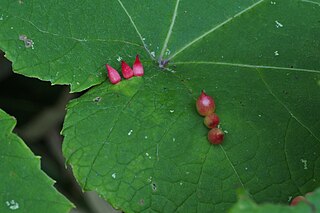Daphnephila truncicola is a species of gall midges first associated with stem galls on Lauraceae species, particularly Machilus thunbergii in Taiwan. Based on analysis on sequences of the mitochondrial cytochrome c oxidase subunit I, it has been suggested that in this genus, the stem-galling habit is a more ancestral state as opposed to the leaf-galling habit. This genus appears to have originated tropically and dispersed to Japan through Taiwan.
Daphnephila ornithocephala is a species of gall midge first associated with leaf galls on Lauraceae species, particularly Machilus thunbergii in Taiwan. Based on analysis on sequences of the mitochondrial cytochrome c oxidase subunit I, it has been suggested that in this genus, the stem-galling habit is a more ancestral state as opposed to the leaf-galling habit. This genus appears to have originated tropically and dispersed to Japan through Taiwan.

Asphondylia is a cosmopolitan genus of gall midges in the family Cecidomyiidae. All species in this genus induce galls on plants, especially on flowers and flower buds. There are over 300 described species in Asphondylia, with many more likely to be discovered and described, especially in the southern hemisphere.

Asphondyliini is a tribe of gall midges in the family Cecidomyiidae. There are about six genera and at least 100 described species in Asphondyliini.

Rabdophaga rigidae, the willow beaked-gall midge, is a species of gall midge in the family Cecidomyiidae. It is found across North America. Some sources state that it is also present in parts of eastern Asia including Japan; however, a 2006 study shows that the Asian populations likely represent a separate species: Rabdophaga salicivora.
Catotricha is a genus of midges in the family Cecidomyiidae. The five described species in Catotricha are found in the holarctic region. This genus was established by British entomologist Frederick Wallace Edwards in 1938.

Ampelomyia vitiscoryloides, the grape filbert gall midge, is a species of gall midge in the family Cecidomyiidae. It induces galls on grape plants and is widespread in eastern North America. It was first described by Alpheus Spring Packard in 1869.
Monardia is a genus of wood midges, insects in the family Cecidomyiidae. The 53 described species in Monardia are grouped into three subgenera.
Micromyinae is a subfamily of wood midges, insects in the family Cecidomyiidae. Its members were formerly included in subfamily Lestremiinae. There are at least 55 genera and more than 650 described species in Micromyinae. All species in this subfamily are mycophageous.
Amedia is a genus of wood midges in the family Cecidomyiidae. The only described species - Amedia floridana - is only known from Florida. The genus was established by Mathias Jaschhof in 1997.

Ampelomyia vitispomum is a species of gall midge in the family Cecidomyiidae. It induces galls on grape plants in eastern North America. It was first described by Carl Robert Osten-Sacken in 1878.
Daphnephila is a genus of gall midge that appears in the Palearctic and Oriental biogeographic realms. Daphnephila species create leaf and stem galls on species of laurel plants, particularly in Machilus. Based on analysis on sequences of the mitochondrial cytochrome c oxidase subunit I, it has been suggested that in this genus, the stem-galling habit is a more ancestral state as opposed to the leaf-galling habit.
Ampelomyia is a genus of gall midges in the tribe Asphondyliini. It consists of the following four species, all of which form galls on grape plants:
Raymond J. Gagné is an American entomologist whose work focuses on gall midges.
Antennardia is a genus of midges in the family Cecidomyiidae. The four described species are found in the Holarctic realm. The genus was first described by Boris Mamaev in 1993, but was subsequently treated as a subgenus of Monardia until being reinstated at the genus level.
Gagnea is a genus of wood midges, insects in the family Cecidomyiidae. The one described species - Gagnea tsutaensis - is known only from Japan. The genus was established by Mathias Jaschhof in 2001 and named after American entomologist Raymond Gagné.
Heterogenella is a genus of wood midges in the family Cecidomyiidae. The twelve described species are found in the Holarctic and Oriental realms. The genus was established by Boris Mamaev in 1963.
Neurolyga is a genus of wood midges, insects in the family Cecidomyiidae. The 28 described species occur in the holarctic region. The genus was established by Italian entomologist Camillo Rondani in 1840.
Pteridomyia is a genus of midges in the family Cecidomyiidae. The four described species are all found in Australasia. The genus was first described by Mathias Jaschhof in 2003.

Ampelomyia conicocoricis is a species of fly in the family Cecidomyiidae. It induces galls on grape plants in Japan. This is the type species for the genus.






